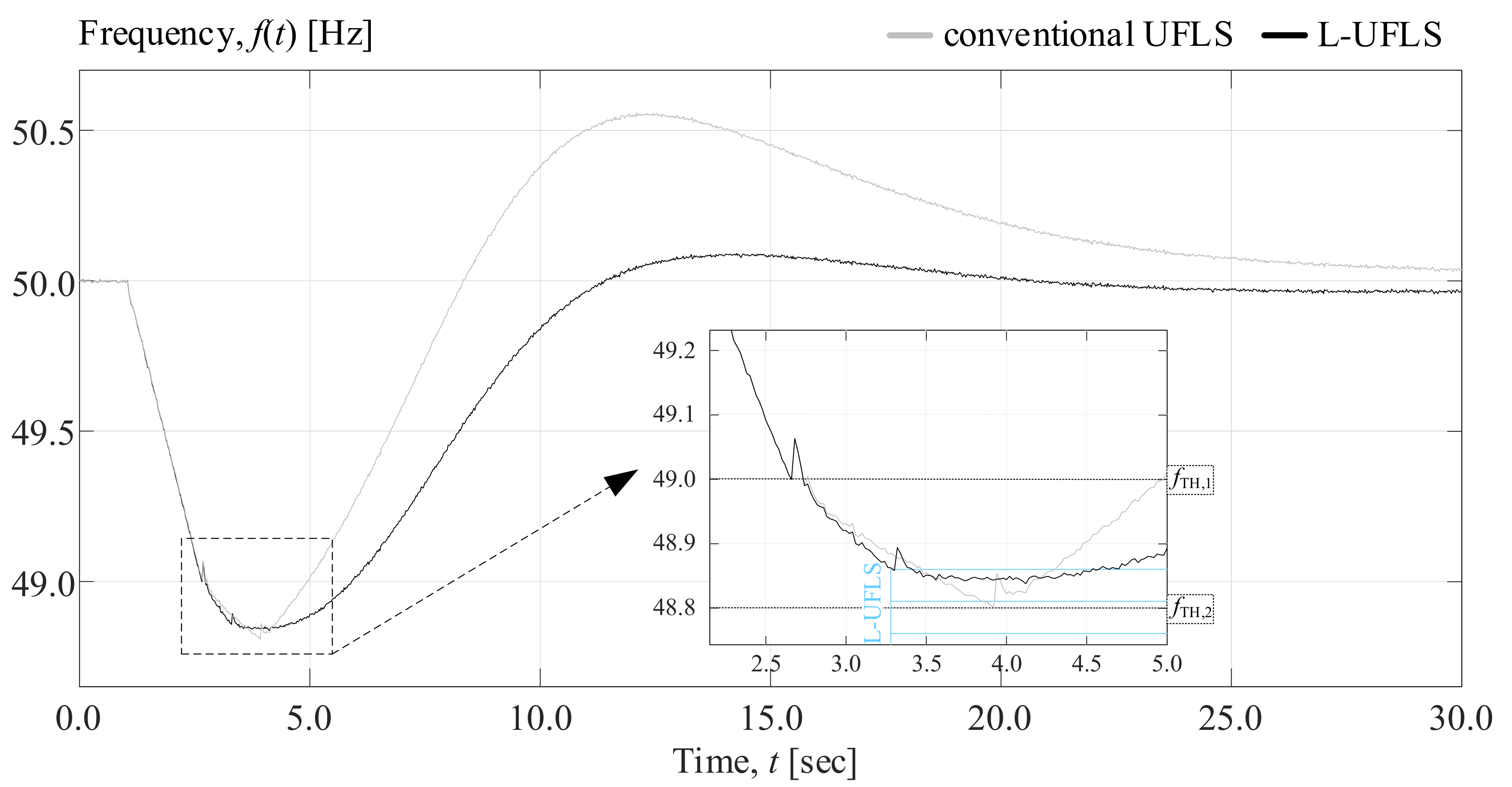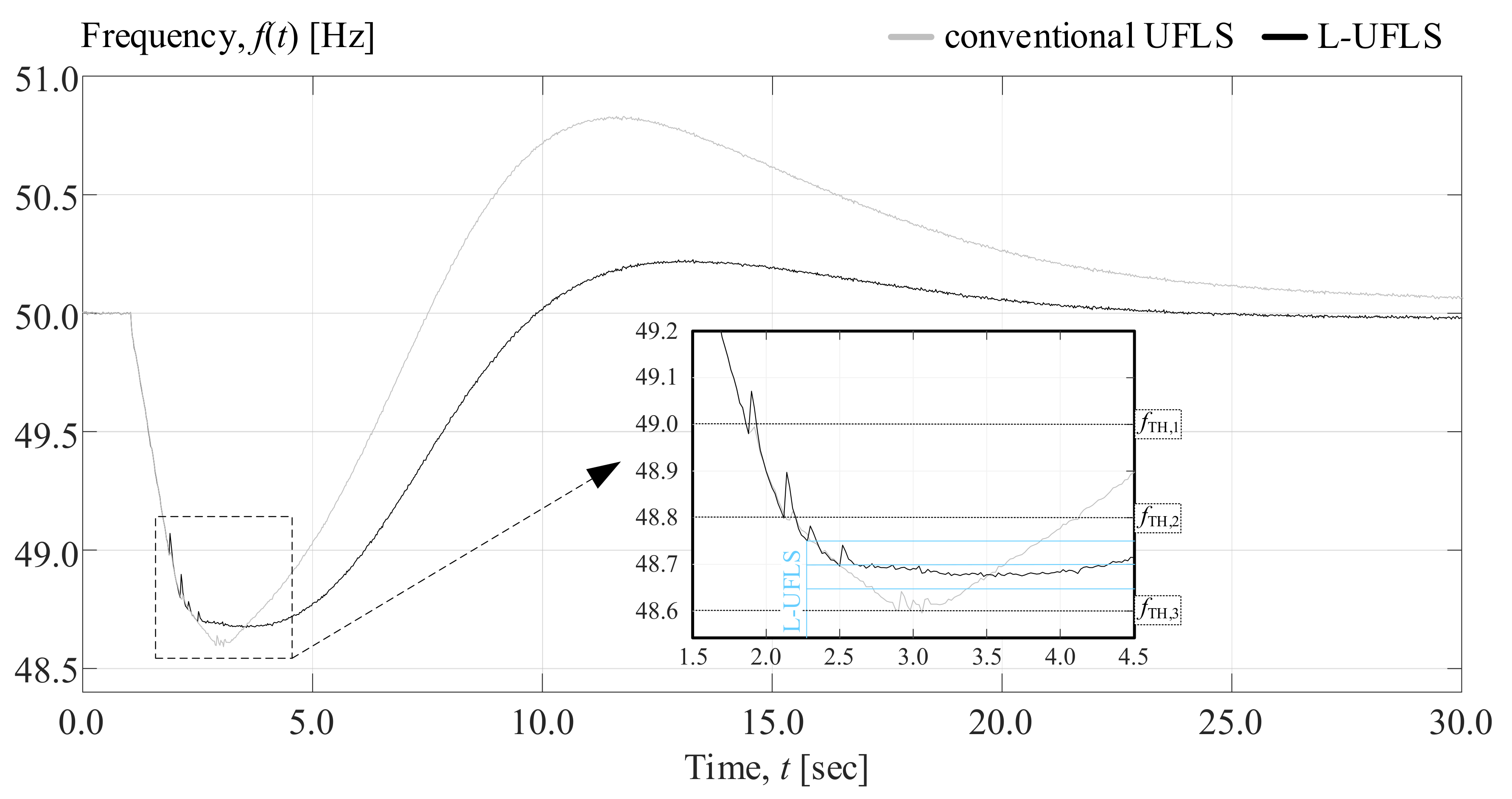Principal Component Analysis (PCA)-Supported Underfrequency Load Shedding Algorithm
Abstract
:1. Introduction
2. Methodology
2.1. Recognition of Frequency-related Conditions
- the presence of intergenerator oscillationsSince IEDs are installed in several EPS locations (substations), measured frequencies are, in general, subject to local electromechanical oscillations between the synchronous generators [10].
- the focus of interestIn pursuing recognition of a frequency trend (e.g., decreasing, increasing, stable, etc.), wider sliding windows are required. On the other hand, if the focus is on recognizing more detailed changes (e.g., load shedding), testing indicates that window lengths of less than 200–500 ms are needed, especially considering the presence of noise in the measurements [11].
2.2. A Short-term Frequency-response Prediction
2.3. Formation of Specialized Time Characteristic
2.4. Self-Adjustment of L-UFLS Setting and Intervention
2.5. L-UFLS Size and Number of Substages
- (1)
- In general, the number of L-UFLS substages depends on the desired level of active power imbalance fine-tuning. Theoretically, full adaptability to any situation could be achieved with an infinite number of load shedding steps. However, physical devices in the real world (relays, circuit-breakers, etc.) require some time to respond to a trip signal, so a large number of substages does not necessarily mean better performance due to their possible overlap. For example, RG CE—Policy 5 [3] recommends a maximum of ten UFLS shedding steps in order to avoid such a situation.
- (2)
- Due to different local frequency conditions, IED detections and actions are not synchronized, nor are their triggering actions. Although this may be perceived as problematic, we believe it is actually an advantage. This is because tripping in this manner is more widely dispersed over time, and consequently, the power adjustment is more continuous compared to a coordinated approach, for which the UFLS actions are synchronized throughout the EPS. As a result, load shedding is more finely tuned and the active power is more accurately balanced. One could even consider this as a virtual introduction of several additional substages.
2.6. IED Requirements
- Real-time frequency measurementThis functionality is already standardized in protection relays and adopted in many other devices as well.
- Capacity to generate three independent output trip signalsThis functionality is already standardized in protection relays. These usually offer even more outputs.
- Machine learning capabilityThe IED must be equipped with a PCA machine learning algorithm.
- Curve-fitting capabilityThe IED must be able to perform fitting of the selected SFR model to the real-time measurements.
- Capacity to perform basic math functions for the evaluation of the expected time before violation of the static frequency limitsThe IED must be able to determine the likely time of violation of the static thresholds and their differences based on the estimated frequency response.
- Capacity to adjust its own triggering conditionsThe IED must be able to modify its own triggering settings.
3. Case Study
4. Conclusions
Author Contributions
Funding
Conflicts of Interest
References
- Matthewman, S.; Byrd, H. Blackouts: A sociology of electrical power failure. Soc. Space J. 2014, 1–25. [Google Scholar]
- ENTSO-E. Continental Europe Operation Handbook, Appendix 1: Load-Frequency Control and Performance; ERRA: Budapest, Hungary, 2009. [Google Scholar]
- ENTSO-E. RG CE OH—Policy 5: Emergency Operations V 3.1. Available online: https://eepublicdownloads.entsoe.eu/clean-documents/pre2015/publications/entsoe/Operation_Handbook/Policy_5_final.pdf. (accessed on 1 August 2010).
- Alhelou, H.H.; Hamedani-Goldshan, M.E.; Njenda, C.T.; Siano, P. A Survey on Power System Blackout and Cascading Events: Research Motivations and Challenges. Energies 2019, 12, 682. [Google Scholar] [CrossRef] [Green Version]
- Sigrist, L.; Rouco, L.; Echavarren, F.M. A review of the state of the art of UFLS schemes for isolated power systems. Electr. Power Energy Syst. 2018, 99, 525–539. [Google Scholar] [CrossRef]
- Shahsavari, A.; Farajollahi, M.; Stewart, E.M.; Cortez, E.; Mohsenian-Rad, H. Situational Awareness in Distribution Grid Using Micro-PMU Data: A Machine Learning Approach. IEEE Trans. Smart Grid 2019, 10, 6167–6177. [Google Scholar] [CrossRef] [Green Version]
- Jackson, J.E. A User’s Guide to Principal Components; John & Wiley, Inc.: Hoboken, NJ, USA, 1991; ISBN 978-0-471-62267-3. [Google Scholar]
- Mohammed, S.B.; Khalid, A.; Osman, S.E.F.; Helali, R.G.M. Usage of Principal Component Analysis (PCA) in AI Applications. Int. J. Eng. Res. Technol. 2016, 5, 372–375. [Google Scholar]
- Bishop, C.M. Pattern Recognition and Machine Learning; Springer: New York, NY, USA, 2006; ISBN 978-0387-31073-2. [Google Scholar]
- Rudez, U.; Mihalic, R. Monitoring the First Frequency Derivative to Improve Adaptive Underfrequency Load-Shedding Scheme. IEEE Trans. Power Syst. 2011, 26, 839–846. [Google Scholar] [CrossRef]
- ENTSO-E. Frequency Measurement Requirements and Usage—Final Version 7, RG-CE System Protection & Dynamics Sub Group; ENTSO-E: Brussels, Belgium, 2018. [Google Scholar]
- Anderson, P.M.; Mirheydar, M. A Low-Order System Frequency Response Model. IEEE Trans. Power Syst. 1990, 5, 720–729. [Google Scholar] [CrossRef] [Green Version]
- Huang, H.; Ju, P.; Jin, Y.; Yuan, X.; Qin, C.; Pan, X.; Zang, X. Generic System Frequency Response Model for Power Grids with Different Generations. IEEE Access 2020, 8, 14314–14321. [Google Scholar] [CrossRef]
- Kundur, P. Power System Stability and Control; McGraw-Hill, Inc.: New York, NY, USA, 1994; ISBN 978-0070-35958-1. [Google Scholar]
- Kopse, D.; Rudez, U.; Mihalic, R. Applying a wide-area measurement system to validate the dynamic model of a part of European power-system. Electr. Power Syst. Res. 2015, 119, 1–10. [Google Scholar] [CrossRef]





| Stage No. | 1 | 2 | 3 | 4 | 5 | 6 |
|---|---|---|---|---|---|---|
| fTH (Hz) | 49.0 | 48.8 | 48.6 | 48.4 | 48.2 | 48.1 |
| size (% of EPS loading) | 10 | 10 | 10 | 10 | 10 | 5 |
Publisher’s Note: MDPI stays neutral with regard to jurisdictional claims in published maps and institutional affiliations. |
© 2020 by the authors. Licensee MDPI, Basel, Switzerland. This article is an open access article distributed under the terms and conditions of the Creative Commons Attribution (CC BY) license (http://creativecommons.org/licenses/by/4.0/).
Share and Cite
Skrjanc, T.; Mihalic, R.; Rudez, U. Principal Component Analysis (PCA)-Supported Underfrequency Load Shedding Algorithm. Energies 2020, 13, 5896. https://doi.org/10.3390/en13225896
Skrjanc T, Mihalic R, Rudez U. Principal Component Analysis (PCA)-Supported Underfrequency Load Shedding Algorithm. Energies. 2020; 13(22):5896. https://doi.org/10.3390/en13225896
Chicago/Turabian StyleSkrjanc, Tadej, Rafael Mihalic, and Urban Rudez. 2020. "Principal Component Analysis (PCA)-Supported Underfrequency Load Shedding Algorithm" Energies 13, no. 22: 5896. https://doi.org/10.3390/en13225896





